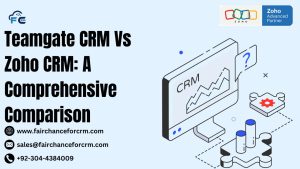Zoho CRM Note Data API is todays our topic. Zoho CRM is one of the most versatile Customer Relationship Management (CRM) tools available, offering businesses robust features to track and manage customer interactions. The Notes API, which lets users create, get, update, and remove notes connected to different CRM records like leads, contacts, deals, or accounts, is one of its helpful features. This post will explain the operation of the Zoom CRM Note Data API and offer a step-by-step implementation guide for your system.
Also Read Related Articles:
- The Power of Salesforce Customer 360 Beyond Traditional CRM
- Microsoft Dynamics 365 Copilot for Intelligent Business Solutions
- How Zoho Integration Elevated Gentsforum Performance?
- Enhancing E-commerce with Zoho and Shopify – FAIRCHANCE FOR CRM
- 7 Reasons Zoho CRM is the Best Choice for E-Commerce
Why Use Zoho CRM Note Data API?
1. Seamless Integration:
The Zoho CRM Note Data API allows businesses to integrate notes functionality into their custom applications. It guarantees that team members, even when not utilizing the Zoho CRM interface, can access critical information about customer interactions.
2. Enhanced Communication:
Teams can preserve communication histories and provide consistent service by adding notes to records, which enhances departmental collaboration.
3. Automated Workflows:
By using the API, you can automate the process of adding, updating, or removing notes. Workflows like task tracking, lead nurturing, or support ticketing systems benefit greatly from this.
Understanding Zoho CRM Note Data API
Zoho CRM’s Notes API allows you to interact with the notes data in the CRM. These are the primary actions you can perform with the API:
- Create a new note
- Fetch existing notes
- Update a note
- Delete a note
API Endpoints
| Action | Endpoint | HTTP Method |
|---|---|---|
| Create | /crm/v2/Notes |
POST |
| Retrieve | /crm/v2/Notes |
GET |
| Update | /crm/v2/Notes/{note_id} |
PUT |
| Delete | /crm/v2/Notes/{note_id} |
DELETE |
Authentication
Zoho CRM uses OAuth 2.0 for authentication. Before making API calls, you need to generate an access token. Here’s a basic process to obtain an access token:
- Register your app in Zoho’s API Console.
- Get the client ID and client secret.
- Generate an OAuth token using the Authorization Code grant type.
Working with Zoho CRM Note Data API: A Step-by-Step Guide
1. Creating a Note
To create a note, you will make a POST request to the /crm/v2/Notes endpoint with the following parameters:
Request Body Example:
{
"data": [
{
"Note_Title": "Follow-up with the client",
"Note_Content": "Scheduled a meeting with the client for next week.",
"Parent_Id": "123456789", // The ID of the associated record (e.g., Lead or Deal)
"se_module": "Leads" // The module the note is associated with
}
]
}
Response:
If successful, you’ll receive a response with the note’s id and other details. The status code 201 indicates that the note was successfully created.
2. Retrieving Notes
You can retrieve existing notes by making a GET request to the /crm/v2/Notes endpoint. You can apply filters to retrieve notes specific to a particular record (e.g., a lead or a contact).
Example Request:
GET https://www.zohoapis.com/crm/v2/Notes?parent_id=123456789
In this case, parent_id refers to the associated record, and the API will return the notes related to that specific lead, deal, or contact.
Example Response:
{
"data": [
{
"id": "1000001",
"Note_Title": "Initial contact",
"Note_Content": "Spoke with the lead, scheduled a follow-up call.",
"Created_Time": "2023-10-01T12:30:00+05:30",
"Modified_Time": "2023-10-01T12:45:00+05:30",
"Parent_Id": "123456789"
}
]
}
3. Updating a Note
To update an existing note, make a PUT request to /crm/v2/Notes/{note_id} with the updated fields. The note_id must be included in the URL.
Example Request:
PUT https://www.zohoapis.com/crm/v2/Notes/1000001
{
"data": [
{
"Note_Content": "Spoke with the lead, scheduled a follow-up call and sent a confirmation email."
}
]
}
A successful response will return a status_code of 200.
4. Deleting a Note
To delete a note, send a DELETE request to /crm/v2/Notes/{note_id}.
Example Request:
DELETE https://www.zohoapis.com/crm/v2/Notes/1000001
On success, a 200 OK status is returned along with a message confirming the deletion.
Example Use Cases of Zoho CRM Notes API
Here are a few real-world scenarios where you might find the Notes API beneficial:
- Customer Support Teams: Automatically add a note when a support ticket is resolved, detailing the resolution.
- Sales Teams: After each customer interaction, notes can be automatically appended to the customer’s CRM record for future reference.
- Task Management Systems: Integrate the Notes API to add updates to tasks or project management tools from within Zoho CRM.
Conclusion
Zoho CRM’s Notes API is a powerful feature that enhances collaboration, ensures that communication history is stored efficiently, and integrates seamlessly with various workflows. Whether you’re building a custom CRM dashboard or automating business processes, leveraging the Notes API can help you streamline note-taking and improve team productivity.
Before implementing the API, make sure to thoroughly review Zoho’s official documentation and best practices to optimize your use of the API. With the Zoho CRM Notes API, your business can ensure that crucial customer information is always documented and accessible to those who need it most.
For more information about the Zoho CRM Note Data API, visit this link.
If you want to Free Trail Zoho, click on this link.




